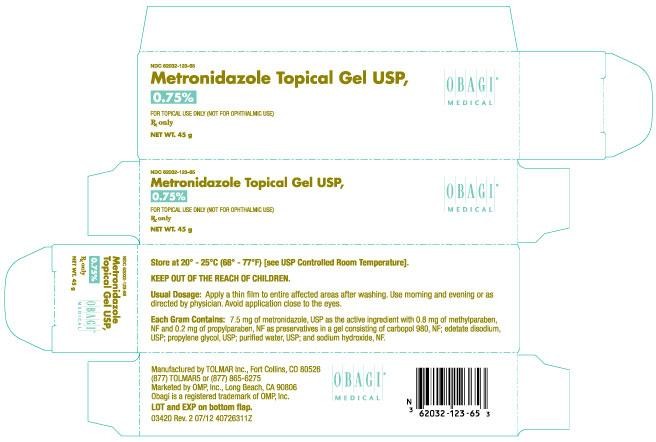Metronidazole
Metronidazole Topical Gel USP, 0.75%
FULL PRESCRIBING INFORMATION
FOR TOPICAL USE ONLY
(NOT FOR OPHTHALMIC USE)
Rx only
Metronidazole topical gel USP, 0.75%, contains metronidazole, USP, at a concentration of 7.5 mg per gram (0.75%) in a gel consisting of carbopol 980, NF; edetate disodium, USP; methylparaben, NF; propylene glycol, USP; propylparaben, NF; purified water, USP; and sodium hydroxide, NF. Metronidazole is classified therapeutically as an antiprotozoal and anti-bacterial agent. Chemically, metronidazole is named 2-methyl-5-nitro-1H-imidazole-1-ethanol and has the following structure:

Bioavailability studies on the topical administration of 1 gram of metronidazole topical gel USP, 0.75%, (7.5 mg of metronidazole) to the face of 10 rosacea patients showed a maximum serum concentration of 66 nanograms per milliliter in one patient. This concentration is approximately 100 times less than concentrations afforded by a single 250 mg oral tablet. The serum metronidazole concentrations were below the detectable limits of the assay at the majority of time points in all patients. Three of the patients had no detectable serum concentrations of metronidazole at any time point. The mean dose of gel applied during clinical studies was 600 mg which represents 4.5 mg of metronidazole per application. Therefore, under normal usage levels, the formulation affords minimal serum concentrations of metronidazole. The mechanisms by which metronidazole topical gel USP, 0.75%, acts in the treatment of rosacea are unknown, but appear to include an anti-inflammatory effect.
Metronidazole topical gel USP, 0.75%, is indicated for topical application in the treatment of inflammatory papules and pustules of rosacea.
Metronidazole topical gel USP, 0.75%, is contraindicated in individuals with a history of hypersensitivity to metronidazole, parabens, or other ingredients of the formulation.
General
Metronidazole topical gel USP, 0.75%, has been reported to cause tearing of the eyes. Therefore, contact with the eyes should be avoided. If a reaction suggesting local irritation occurs, patients should be directed to use the medication less frequently or discontinue use. Metronidazole is a nitroimidazole and should be used with care in patients with evidence of, or history of blood dyscrasia.
Information for Patients
This medication is to be used as directed by the physician. It is for external use only. Avoid contact with the eyes.
Drug Interactions
Oral metronidazole has been reported to potentiate the anticoagulant effect of coumarin and warfarin resulting in a prolongation of prothrombin time. The effect of topical metronidazole on prothrombin time is not known.
Carcinogenesis, Mutagenesis, Impairment of Fertility
Metronidazole has shown evidence of carcinogenic activity in a number of studies involving chronic, oral administration in mice and rats but not in studies involving hamsters.
Metronidazole has shown evidence of mutagenic activity in several in vitro bacterial assay systems. In addition, a dose-response increase in the frequency of micronuclei was observed in mice after intraperitoneal injections and an increase in chromosome aberrations have been reported in patients with Crohn's disease who were treated with 200-1200 mg/day of metronidazole for 1 to 24 months. However, no excess chromosomal aberrations in circulating human lymphocytes have been observed in patients treated for 8 months.
Pregnancy
Teratogenic effects: Pregnancy category B: There has been no experience to date with the use of metronidazole topical gel USP, 0.75%, in pregnant patients. Metronidazole crosses the placental barrier and enters the fetal circulation rapidly. No fetotoxicity was observed after oral metronidazole in rats or mice. However, because animal reproduction studies are not always predictive of human response and since oral metronidazole has been shown to be a carcinogen in some rodents, this drug should be used during pregnancy only if clearly needed.
Nursing Mothers
After oral administration, metronidazole is secreted in breast milk in concentrations similar to those found in the plasma. Even though metronidazole topical gel USP, 0.75%, blood levels are significantly lower than those achieved after oral metronidazole, a decision should be made whether to discontinue nursing or to discontinue the drug, taking into account the importance of the drug to the mother.
Pediatric Use
Safety and effectiveness in pediatric patients have not been established.
The following adverse experiences have been reported with the topical use of metronidazole: burning, skin irritation, dryness, transient redness, metallic taste, tingling or numbness of extremities and nausea.
Apply and rub in a thin film of metronidazole topical gel USP, 0.75%, twice daily, morning and evening, to entire affected areas after washing.
Areas to be treated should be cleansed before application of metronidazole topical gel USP, 0.75%. Patients may use cosmetics after application of metronidazole topical gel USP, 0.75%.
Metronidazole topical gel USP, 0.75%, is supplied as the following:
NDC 62032-123-65: 45 g aluminum tube
Storage conditions: Store at 20° - 25°C (68° - 77°F) [see USP Controlled Room Temperature].
If you have questions:
All questions of a medical nature should be taken up with your doctor. For more information about Metronidazole, call our toll-free number:
(877) TOLMAR5 or (877) 865-6275.
Call your doctor for medical advice about side effects. You may report side effects to FDA at 1-800-FDA-1088.
44438 Rev. 1 06/12 60726311Z

Marketed by OMP, Inc.
Long Beach, CA 90806
Manufactured by
TOLMAR Inc.
Fort Collins, CO 80526
Obagi is a registered trademark of OMP, Inc.


MetronidazoleMetronidazole GEL
| |||||||||||||||||||||||||||||||||||||||||||||||||||||||||||||||||||||||||